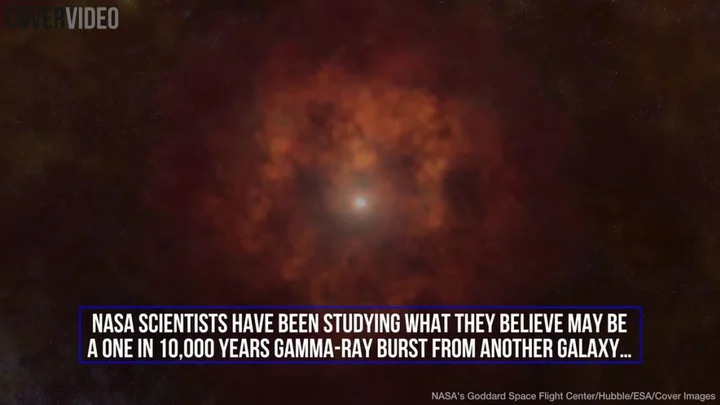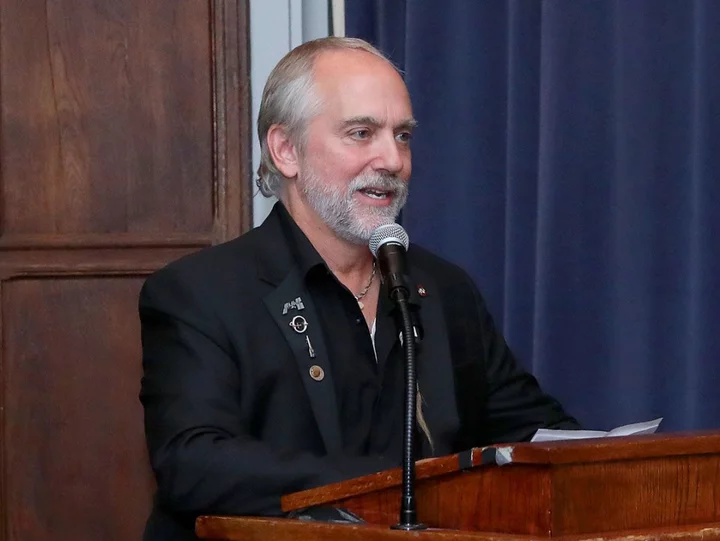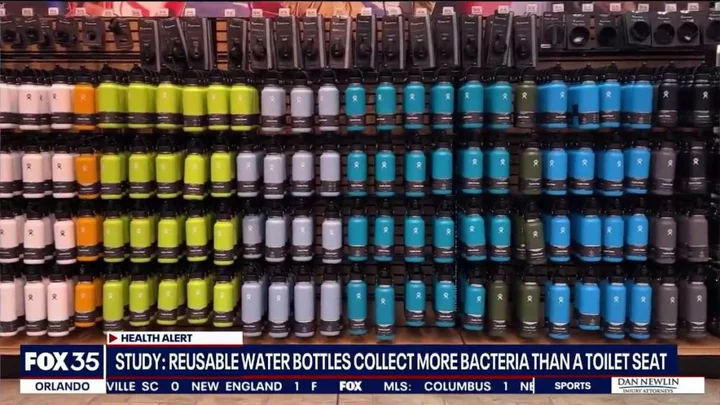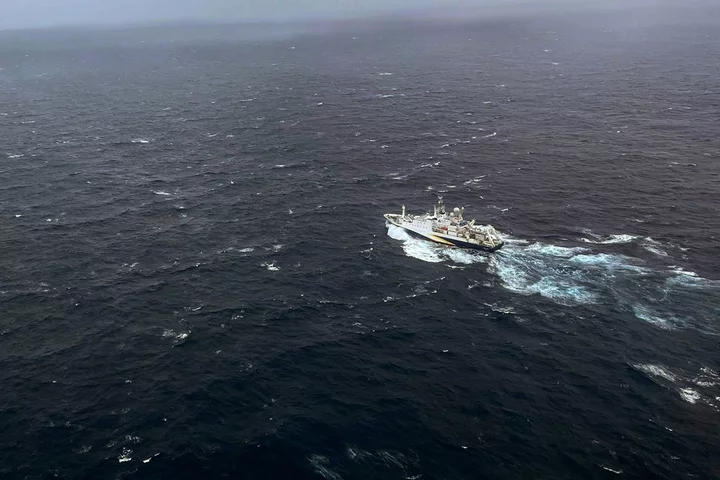
Astronomers discover a totally new way that stars can die
Astronomers have discovered a new way that stars can die. In a study published in the journal Nature Astronomy, experts have worked out that a minute-long gamma-ray burst of light, which occured in 2019 and evidence a star dying, happened because stars collided within the densely crowded environment near the supermassive black hole at the centre of an ancient galaxy. Normally gamma-ray bursts (GRB) last around two seconds and happen when stars collapse. “For every hundred events that fit into the traditional classification scheme of gamma-ray bursts, there is at least one oddball that throws us for a loop,” said study coauthor Wen-fai Fong, assistant professor of physics and astronomy at Northwestern University’s Weinberg College of Arts and Sciences, in a statement. “However, it is these oddballs that tell us the most about the spectacular diversity of explosions that the universe is capable of.” Over time, astronomers have observed three main ways that stars can die, depending on their size. Lower mass stars like our sun shed their outer layers as they age, eventually becoming dead white dwarf stars. Sign up to our free Indy100 weekly newsletter Massive stars burn through the fuel-like elements at their core and shatter in explosions called supernovas. Doing so can leave behind dense remnants like neutron stars or result in the creation of black holes. A third form of star death results when neutron stars or black holes begin to orbit one another in a binary system and spiral closer to one another until they collide and explode. But the new observation suggests a fourth type of death. “Our results show that stars can meet their demise in some of the densest regions of the universe, where they can be driven to collide,” said lead study author Andrew Levan, an astrophysics professor at Radboud University in Nijmegen, Netherlands, in a statement. “This is exciting for understanding how stars die and for answering other questions, such as what unexpected sources might create gravitational waves that we could detect on Earth.” “The lack of a supernova accompanying the long GRB 191019A tells us that this burst is not a typical massive star collapse,” said study coauthor Jillian Rastinejad, a doctoral student of astronomy at Northwestern, in a statement. “The location of GRB 191019A, embedded in the nucleus of the host galaxy, teases a predicted but not yet evidenced theory for how gravitational-wave emitting sources might form.” “While this event is the first of its kind to be discovered, it’s possible there are more out there that are hidden by the large amounts of dust close to their galaxies,” said Fong, who is also a member of the Center for Interdisciplinary Exploration and Research in Astrophysics at Northwestern. “Indeed, if this long-duration event came from merging compact objects, it contributes to the growing population of GRBs that defies our traditional classifications.” You learn something new every day. Have your say in our news democracy. Click the upvote icon at the top of the page to help raise this article through the indy100 rankings.
1970-01-01 08:00

Top Explorer Urges Caution With Boom in Sea and Space Adventures
The demise of five people aboard a submersible touring the Titanic’s underwater wreckage has even the most prominent
1970-01-01 08:00

Scientists have come up with a new meaning of life – and it's pretty mind-blowing
The meaning of life is the ultimate mystery – why do we exist? And is there a point to… well… anything? These are questions to which we may never find answers, but at least we can define what “life” means in scientific terms. And yet, our understanding of what life is is changing all the time, thanks to space exploration. As scientists continue to hunt for life beyond our own world, biologists are having to rethink the meaning of the word “life” itself. Sign up for our free Indy100 weekly newsletter Generally, biologists explain “life” as connoting a self-sustaining chemical system which is capable of performing functions such as eating, metabolising, excreting, breathing, moving, growing, reproducing, and responding to external stimuli. This definition works pretty well here on Earth (although there are some important exceptions, such as viruses), but experts have pointed out that if life exists elsewhere in the universe, it may not display the same properties that we’re used to. Indeed, it might be unrecognisable as life as we know it (forget those little green men). In which case, how will we spot it if it ever crosses our path? Astrobiologist Sara Imari Walker and chemist Lee Cronin think they’ve come up with a solution. The pair are now arguing that highly complex molecules found in all living creatures can’t exist thanks purely to chance. Therefore, they say, the universe must have a way of creating and reproducing complex information and retaining a “memory” of all of this.. In an interview with New Scientist, Walker, of Arizona State University, explained their radical idea on how objects come into existence. The concept, known as Assembly Theory, explains why certain complex objects have become more abundant than others by considering their histories. If the theory proves correct, it will redefine what we mean by “living” things and show that we’ve been going about the search for extraterrestrial life all wrong. In the process, we could even end up creating alien life in a laboratory, she stressed. In her discussion with New Scientist, Walker pointed out: "An electron can be made anywhere in the universe and has no history. You are also a fundamental object, but with a lot of historical dependency. You might want to cite your age counting back to when you were born, but parts of you are billions of years older. "From this perspective, we should think of ourselves as lineages of propagating information that temporarily finds itself aggregated in an individual." Assembly theory predicts that molecules produced by biological processes must be more complex than those produced by non-biological processes, as Science Alert notes. To test this, Walker and her team analysed a range of organic and inorganic compounds from around the world and outer space, including E. coli bacteria, urine, meteorites and even home-brewed beer. They then smashed up the compounds into smaller pieces and used mass spectrometry to pinpoint their molecular building blocks. They calculated that the smallest number of steps required to reassemble each compound from these building blocks was 15. And whilst some compounds from living systems needed fewer than 15 assembly steps, no inorganic compounds made it above this threshold. "Our system … allows us to search the universe agnostically for evidence of what life does rather than attempting to define what life is," Walker, Cronin, and others wrote in a 2021 Nature Communications article. The handy thing about this building block system – which they’ve dubbed the “'molecular assembly index” – is that it doesn’t rely on carbon-based organic materials to be identified. In other words, an alien could be made of entirely different stuff entirely and we’d still be able to spot it as life using the index. It also works regardless of what stage of “life” an extraterrestrial being is in – whether it is still in its infancy or has moved into a technological stage beyond our understanding. That’s because all of these states produce complex molecules which couldn’t exist in the absence of a living system. If all of this is hurting your head, let’s just get back to the basics: if there is a secret to life, it might all be down to what we do, not what we are. Have your say in our news democracy. Click the upvote icon at the top of the page to help raise this article through the indy100 rankings.
1970-01-01 08:00

Heartbeat sensors on shopping trolleys 'could save lives', new study suggests
New findings have suggested that adding sensors to supermarket trolleys could save people’s lives. Scientists investigated whether installing electrocardiogram (ECG) sensors – designed to check the heart’s rhythm – on the handles of supermarket, trolleys could identify shoppers with atrial fibrillation, which causes an irregular and often abnormally fast heart rate. The sensors would detect heart conditions that put them at increased risk of stroke. The researchers said that over the course of two months, they identified 39 people who were unaware that they had the condition. Ian Jones, professor of cardiovascular nursing at Liverpool John Moores University, who led the study, said: “That’s 39 people at greater risk of stroke who received a cardiologist appointment.” He added: “This study shows the potential of taking health checks to the masses without disrupting daily routines.” It is estimated that around 1.5 million people in the UK have atrial fibrillation, contributing to one in five strokes. The condition is treatable, but at least another 270,000 people in the UK remain undiagnosed and unaware, according to the British Heart Foundation. Sign up for our free Indy100 weekly newsletter There are wearable devices that can also spot irregular heartbeat but this would also require people to take responsibility and wear the device. Professor Jones said: “Nearly two-thirds of the shoppers we approached were happy to use a trolley, and the vast majority of those who declined were in a rush rather than wary of being monitored. “This shows that the concept is acceptable to most people and worth testing in a larger study.” He added: “Checking for atrial fibrillation while people do their regular shopping holds promise for preventing strokes and saving lives. “A crucial aspect is providing immediate access to a health professional who can explain the findings and refer patients on for confirmatory tests and medication if needed.” The findings were presented at ACNAP 2023 conference organised by the European Society of Cardiology (ESC). Have your say in our news democracy. Click the upvote icon at the top of the page to help raise this article through the indy100 rankings.
1970-01-01 08:00

Reusable bottles contain 'more bacteria than toilet seats'
Reusable water bottles tick many boxes. Not only do they help you stay hydrated and help save money, but they also help cut down on single-use plastic. They've almost become a fashion accessory, with chic stainless steel flasks and viral bottles going viral across TikTok. Sign up for our free Indy100 weekly newsletter Trying to hit the NHS-recommended eight glasses of water a day for adults is an excellent idea, of course, but did you know there’s one way your refillable bottle could potentially be detrimental to your health? According to a study from waterfilterguru.com, reusable water bottles contain an average of 20.8m colony-forming units (CFUs) of bacteria, which equates to 40,000 times more than the microbes on a toilet seat. So what might be the consequences if you continuously sip and refill without washing your bottle properly between uses? We asked health experts to talk through the risks… Bottling up bacteria “A common misconception when it comes to reusable water bottle hygiene is that as you’re typically filling it with pure water and it’s only coming into contact with your own mouth, there’s little need to clean it often,” says Dr Donald Grant, senior clinician at The Independent Pharmacy. However, every time you drink from the bottle, you’re transferring bacteria from your mouth, which can then multiply in the container. “Anything that is reusable can be prone to accumulating dirt, dust or debris and, as a result, bacteria,” says private GP Dr Suhail Hussain. “This is exacerbated by the fact water bottles are the ideal environment for harbouring bacteria due to being moist.” Hard-to-reach crevices – for example, inside a screw top or under a flip-up straw – could also develop mould, and then there’s contamination from other sources. “When you store it in a gym bag, for instance, it can pick up bacteria from the interior of the bag or anything else stored in it, while you can also transfer bacteria from your hands to your bottle,” says Grant. “If your bottle has a valve cap, you may need to lift or twist it with your fingers, and this can transfer bacteria you may have picked up from touching other objects or surfaces.” What types of microbes are found in water bottles? “These might be simple commensals such as streptococcus and staphylococcus, which normally live in symbiosis with their host (i.e. us) but can become problematic if they accumulate or the individual is under the weather,” Hussain says. “Bacteria such as E. coli – a common cause of urine and bowel infections – can often colonise the water bottle following repeated handling, such as taking the cap on and off.” These bacteria can potentially cause a variety of issues. “You may become sick and develop gastric illness, such as diarrhoea or vomiting,” Hussain continues. “Gram negative rods – another common bacterium found in unwashed bottles – can lead to urogenital tract infections and pneumonia.” Grant warns: “If there’s a build-up of mould inside the bottle, this can cause allergy symptoms, such as a runny nose, sneezing, or red and itchy eyes. Symptoms might be more severe for someone with asthma.” How often should you wash your reusable water bottle? “To minimise your risk of getting sick, you should ideally clean your water bottle after each use,” Grant says. “As a minimum, you should aim to wash it thoroughly at least a few times a week.” Hot water and washing up liquid are all you need to banish bacteria on a daily. “Fill the bottle with hot soapy mixture and swill around, or leave to soak in a detergent mixture,” Hussain advises. “Remember to pay special attention to lids/caps and screw top regions – use a clean brush [to scrub them].” If you’ve neglected your bottle for a few days and it needs a deeper clean, Grant suggests: “Soak your bottle overnight in a solution of half vinegar and half water. Rinse the bottle and let it dry fully before using it again.” Storage is also important to help minimise nasty microbes. “Where possible, you should keep your water bottle out of germ-rich environments such as your gym locker or sports bag,” Grant says. “You should also avoid filling your bottle with anything other than water, such as protein shakes, energy drinks, or sugar-rich liquids, as sugar can stimulate the growth of bacteria.” Hussain adds: “Don’t leave a water bottle in the sun for long periods or sitting in the cup holder in the car – the mixture of warmth and moisture is likely to make bacterial overgrowth worse.” Have your say in our news democracy. Click the upvote icon at the top of the page to help raise this article through the indy100 rankings.
1970-01-01 08:00

Britain Saw A Record Wildfire Season in 2022. It Still Hasn’t Raised Its Game
Even as Britain prepares to bake again this weekend, the country is not geared up any better for
1970-01-01 08:00

Gas Is Here to Stay for Decades, Say Fossil Fuel Heavyweights
The biggest fossil fuel players are making the message clear: the transition to a green future will require
1970-01-01 08:00

Eli Lilly’s Experimental Weight-Loss Pill Show Rapid Results in Study
Eli Lilly & Co.’s experimental weight-loss pill helped patients shed pounds quickly in a mid-stage trial, setting the
1970-01-01 08:00

Sub Disaster Puts Spotlight on Another Extreme Venture: Space Tourism
Commercial space travel shares plenty of similarities with deep sea tourism: wealthy customers, tight spaces, far-flung destinations and
1970-01-01 08:00

Inside Titanic director James Cameron's obsession with the deep ocean
Public interest in the deep ocean went into a frenzy this week as the search for the doomed Titan submarine played out – and Oscar-winning film director has made no secret of the fact that he is obsessed with the subject. Since it emerged on 22 June that the Titan was destroyed in what US authorities called a “catastrophic implosion”, Cameron has been telling media outlets that he knew what the five-man crew’s fate was since Monday, four days earlier. After calling up his “contacts in the deep submersible community” Cameron said he had already ascertained that the vessel had been destroyed in an implosion. “I felt in my bones what had happened.” Sign up to our free Indy100 weekly newsletter But why does Cameron know so much about the ocean depths? Titanic, Avatar and The Abyss First of all, Cameron has made a lot of films about the bottom of the sea. His 1997 film, Titanic, won 11 Oscars and was the first movie to earn more than $1bn worldwide, and Cameron went deep on his research – literally. The filmmaker has visited the real-life wreck of the Titanic 33 times, making his first trip in 1995 to shoot footage for the film. One of those dives even involved getting trapped with the wreck for 16 hours, with currents of water holding the director’s submarine at the bottom of the ocean. He has even written a book about his experiences, Exploring The Deep, which includes details of his dive journey, photos and maps from his own explorations of the wreck. He told ABC News: “I actually calculated [that] I've spent more time on the ship than the captain did back in the day.” Long before Titanic, Cameron directed The Abyss in 1989. The premise of the film is that an American submarine sinks in the Caribbean – sound familiar? That prompts a search and recovery team to race against Soviet vessels to recover the boat. Meanwhile, the last movie in Cameron’s famous Avatar franchise, The Way of Water, is set on the aquatic ecosystems of a world 25 trillion miles from Earth. "Some people think of me as a Hollywood guy … (but) I make 'Avatar' to make money to do explorations," Cameron told The Telegraph. Going even deeper In 2012, Cameron went a step further, plunging nearly 11km down to the deepest place in the ocean, the Mariana Trench in the western Pacific. The filmmaker made the solo descent in a submarine called the Deepsea Challenger, and it took more than two hours to reach the bottom. The submarine he used was years in the making, designed by Cameron himself with a team of engineers. The trip was only the second manned expedition to the Mariana Trench. The first was in 1960, when US Navy Lieutenant Don Walsh and Swiss scientist Jacques Piccard descended to the ocean floor. “It was absolutely the most remote, isolated place on the planet,” Cameron said in a later interview. “I really feel like in one day I've been to another planet and come back.” He was even underwater when 9/11 happened His obsession with the ocean goes back to age 17, he told the New York Times, when he learned to scuba dive, when he said he felt like he had discovered the "keys to another world”. And between making Titanic in 1997 and Avatar in 2009 Cameron didn’t make a feature film. But he did make documentaries about sea exploration. One of those, 2003’s Ghosts of the Abyss, showed Cameron's travels to the Titanic, while the other, 2005’s Aliens of the Deep, saw Cameron team up with NASA scientists to explore the sea creatures of mid-ocean ridges. Cameron’s fascination even meant he was inside a submersible vessel exploring the Titanic on 11 September 2001, when terrorists flew two passenger jets into the World Trade Centre. It was only after the now-68-year-old director and his crew finished their expedition and returned to the main ship that Cameron learned what had happened. “What is this thing that’s going on?” Cameron asked the late actor Bill Paxton, who played treasure hunter Brock Lovett in the film. “The worst terrorist attack in history, Jim,” Paxton said. Cameron realised he “was presumably the last man in the Western Hemisphere to learn about what had happened,” he told Spiegel in 2012. Have your say in our news democracy. Click the upvote icon at the top of the page to help raise this article through the indy100 rankings.
1970-01-01 08:00

Scientists discover centuries old 'echo' from supermassive black hole
The universe appears to be speaking to us, after a centuries old “echo” from a supermassive black hole was detected by scientists. The black hole located inside the Milky Way became active around 200 years ago and produced a sound that is now being studied. The research was published in Nature and focuses on the black hole named Sagittarius A* (Sgr A*) found 26,000 light-years away from Earth. The noise was triggered when the object consumed gas and dust, with particles moving into the event horizon. The findings could teach us more about the activity of supermassive black holes, which continue to intrigue and confound scientists. Sign up to our free Indy100 weekly newsletter Author of the research Dr Frederic Marin of Strasbourg University said: “It reveals the past awakening of this gigantic object – which is four million times more massive than the Sun. “Our work presents the missing piece of evidence that X-rays from the giant molecular clouds are due to reflection of an intense, yet short-lived flare produced at or nearby Sagittarius A*. These results can further constrain the past activity of the galactic centre.” By their very nature, black holes are difficult to study as they absorb light around them, and these new findings offer insight into a fascinating part of space. Dr Marin said: “To get an idea of the increase in intensity of the X-ray emission when the black hole emerged from its quiescent state, it is as if a single glow-worm hidden in a forest suddenly became as bright as the Sun. “These findings explain why galactic molecular clouds near Sgr A* are shining more brightly than usual. It is because they are reflecting the X-rays emitted by Sgr A* 200 years ago.” Have your say in our news democracy. Click the upvote icon at the top of the page to help raise this article through the indy100 rankings.
1970-01-01 08:00

Titanic Sub Crew Dead After Vessel’s Catastrophic Implosion
The five crew members on the missing submersible that was headed to the Titanic died from a “catastrophic
1970-01-01 08:00
